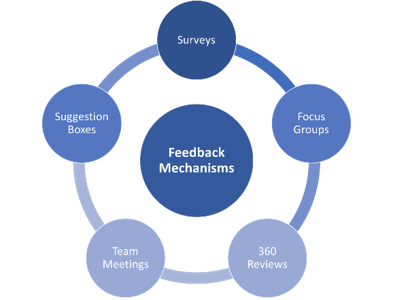Part 2 – Feedback Unlocks Understanding
In our previous blog in this series, we explored how any negative messages the talent market hears from your employees can damage your employer brand, resulting in difficulty attracting new talent. Developing an accurate understanding of your employees’ experience and addressing any issues is crucial for aligning your “true” reputation with your branding. This ultimately supports recruiting activity, as well as helps you retain the quality talent you already have.
There are many ways to develop an understanding of your employees’ experience. The approach that we have seen to be the most successful includes providing employees with the opportunity to provide feedback and using that feedback to make improvements. The benefit of collecting feedback from your employees is two-fold: 1) it provides insights into areas to focus on for improvement, and 2) it shows your team members that you value their opinion and, therefore, can actually help improve employee satisfaction.

The following methods can be used to elicit the perspectives of your team members:
• Surveys – An organization-wide Employee Feedback Survey is proven method for quickly gauging employee satisfaction and gathering data points on specific areas of opportunity. That said, response rates are often lower than desired, and feedback is typically only surface level. One thing you can do to improve the quality and quantity of responses is to allow participants to remain anonymous.
• Focus Groups – Creating focus groups with diverse participants that include representation from all the different business functions, levels, and backgrounds enables you to dig deeper into your employees’ experience. With this method, it is crucial to create an atmosphere of transparency, honestly, and impartiality as focus group members will only be truly honest about their experience if they feel safe. In addition, because participants only represent a sample size of your talent, it is important to pair focus groups with at least one other method.
• 360 Reviews – Although commonly used in many organizations for individual development, 360 Reviews are rarely utilized in aggregate to identify trends. By finding a way to keep the feedback anonymous and analyzing the collective data, you can unlock the pain points employees are confronted by within your organization.
• Team Meetings – Regularly scheduled in-person team meetings are a great opportunity to seek feedback from employees. Allocate just 15 minutes at least one a month to allow employees to speak about any roadblocks or issues they are having throughout day-to-day operations.
• Suggestion Boxes – Physical suggestion boxes have become a thing of the past, but organizations can leverage electronic means of gathering the same information. The most common method is to set up an email account that employees can use to send suggestions, which will be taken under consideration by the leadership team.
Although the methods above are immensely helpful in developing a better understanding of your employee’s experience, the key to making any of them successful is developing a feedback culture and instilling an open-door policy. In addition, to truly get an accurate picture, it helps to have an impartial party lead or support this effort to ease employees’ feelings of discomfort about sharing negative feedback upwards in their organization. That said, the most vital part of ensuring a continuous loop of quality feedback is to show your employees that they are heard by actually doing something with the feedback and making necessary changes – we will discuss this more in our next blog in this series.
In addition to collecting employee feedback, you should also be conducting research on stories in the market. This includes regularly checking online reviews posted on websites like Glassdoor and Indeed. Furthermore, keep an ear to the ground and communicate with the talent market about what candidates may be hearing about your organization and its work environment. In this case, no news is not necessarily good news and ignorance is certainly not bliss – you want to hear the positive stories about you as an employer because, if they are reaching your ears, they are reaching your potential candidates’ ears as well.
Having a baseline understanding of your reputation and your employees’ experience tells you whether your employees confirm your employer brand marketing. It also helps you pinpoint areas that may be misaligned. In our next blog in this series, we will discuss the ways to address these areas and improve employee satisfaction – therefore, allowing you to align your reputation with your branding and enhance your ability to recruit – and retain – quality talent.
Written by: Jackie McMann
About the Author: Jackie McMann is a Manager at McMann & Ransford with extensive experience working with Fortune 500 clients to transform their business models, develop differentiated portfolios, and inject best practices into professional services.
